Topologically protected quantum states are new to the photonics community and represent tremendous opportunity for original research and applications.
ANDREA BLANCO-REDONDO, NOKIA BELL LABS
The use of topology to protect quantum information is well known to the condensed-matter community and, indeed, topological quantum computing is a burgeoning field of research. It is one of the competing avenues to demonstrate that quantum computers can complete certain problems that classical computers cannot.
In photonics, however, we are only beginning to glimpse the potential of topologically protected photonic quantum states. A handful of experiments have proved signatures of robustness in single photons coupled to topological edge states, and just recently, research has shown that the topology can provide protection to spatial features of biphoton states, and even spatially entangled photonic states. The goal of these pioneering proof-of-principle experiments is to highlight the potential of topology to protect quantum states from disorder and defects, which could change the future landscape in photonic quantum computing1.
The field of topological photonics started about a decade ago, when Nobel Prize winner Duncan Haldane and his student at
the time, Srinivas Raghu, theoretically proposed that certain periodic photonic structures — with special properties in their
dispersion bands — could support unidirectional propagation of modes on their edges, with immunity to backscattering. These special properties in the dispersion bands are called topologies, or topological invariants, and they are quantities that characterize the collective behavior of all the wave functions in a band. Topological invariants cannot vary continuously and are therefore robust to disorder and small imperfections.
Haldane and Raghu’s discovery of topological phases of light built upon the earlier discovery of topological phases of matter. Since then, a torrent of inventive theoretical and experimental proposals of topologically robust light propagation has flooded the photonics research scene2. The vast majority of proposals have focused on studying the impact of topology on classical states of light. However, with the recent resurgence of optimism for photonic quantum technologies, a few groups around the world have identified the potential that
topological photonic systems could have in protecting the inherently fragile multiphoton quantum states involved in quantum information.
The importance of protecting multiphoton entangled states was highlighted in two theory papers in 20163,4. To encode quantum information, photons are inherently more robust than matter-based alternatives, given that photons do not decohere and barely interact with the environment. Multiphoton entangled states can be destroyed, however, by scattering and phase errors, and this is where topology can play a vital role.
In the last year, two crucial experimental breakthroughs toward the protection of quantum states were made. The first was the experimental demonstration of topological protection of biphoton states5. Building on this important result, it has recently been demonstrated that topology can protect spatially entangled biphoton states6. In particular, this research showed that spatial features of the correlation map of entangled biphoton states remained unperturbed in the presence of disorder. These proof-of-concept experiments are significant because, in the integrated photonics approach to quantum information systems, spatial entanglement is the preferred type of entanglement for encoding information. In parallel, other research efforts are focused on advancing toward topological protection of spectral correlations and polarization entanglement.
Robust photons on chip
Whereas the initial experiments looking at topological protection of quantum light were performed in free space, it is in integrated platforms that topological photonics can offer a real advantage and provide protection against fabrication disorder and defects. The pioneering experiments discussed pursue a CMOS-compatible approach to topological photonics using silicon photonic chips (Figure 1).
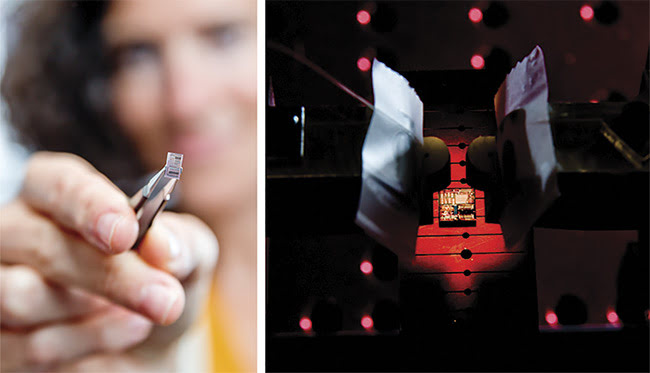
Figure 1. Integrated photonic chips including topological lattices of silicon nanowires. Courtesy of Andrea Blanco-Redondo.
The advantages of using nanophotonic platforms for these kinds of experiments are manifold and include high confinement of light (leading to high nonlinearities that can be harnessed to create correlated and entangled states on chip), a compact footprint, and low-power operation.
There are various approaches for achieving nontrivial topologies in nanophotonics, including the use of microring resonators, bidimensional photonic crystals, nanoparticles, and waveguide arrays. (The waveguide array approach is the simplest and was used on the topological quantum experiments of References 5 and 6). This approach relies on lattices of standard silicon nanowires with alternate long and short gaps (Figure 2a). This structure gives rise to a Su-Schrieffer-Heeger (SSH) Hamiltonian7, which is a bipartite Hamiltonian that exhibits a topological photonic bandgap. The quasi-energy is embodied here by the propagation constant of each of the eigenmodes of the lattice (kz) (Figure 2b).
When a long-long defect is introduced in the otherwise alternate pattern of long and short gaps (Figure 2a, enlarged detail) a defect mode appears in the middle of the bandgap (Figure 2b). This defect mode (red dot) is well isolated from the rest of the extended modes (black continuum) and its amplitude is localized around the long-long defect. More importantly, the propagation constant of this defect mode is protected against disorder by the topology of the structure.
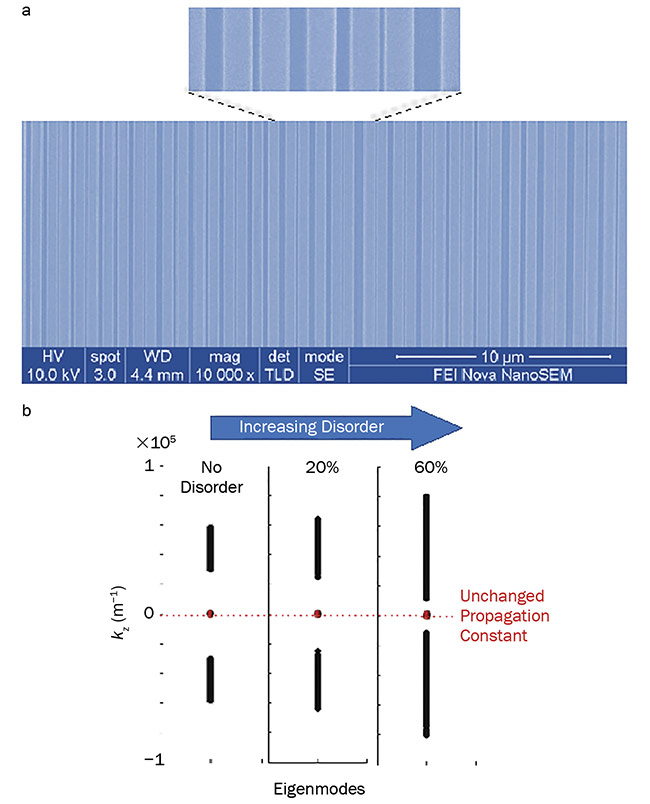
Figure 2. A scanning electron micrograph image of the bipartite lattice of silicon nanowires (a). Detail
of the long-long defect at the center of the lattice (a, enlarged detail). Propagation constant (kz) of every
eigenmode supported by the lattice of 203 waveguides. A bandgap appears as a consequence of the
bipartite nature of the lattice, and a topological defect mode (red dot) appears in the middle of the bandgap as a consequence of the long-long defect. The kz of the topological mode remains unchanged in the presence of disorder (b). Adapted from References 5 and 6. Courtesy of Andrea Blanco-Redondo.
This is observable in Figure 2b, where disorder in the gaps between the waveguides is introduced and it is observed that even if the bandgap becomes smaller, the propagation constant of the defect mode remains unchanged.
Generating quantum states
Quantum states of light can be generated on chip by harnessing the high nonlinear effect of the silicon nanowires. The correlated photon pairs (biphotons) are generated in the lattice by spontaneous four-wave mixing (SFWM). This is a nonlinear process in which two photons at a pump frequency get annihilated to give rise to signal and idler photons of higher and lower frequency, respectively, than the pump, in a process that satisfies energy and momentum conservation. These signal and idler photons, represented by the blue and red spheres (Figure 3), are thus correlated in frequency. By controlling the position of the pump in the lattice, one can control in which lattice modes the biphotons are generated.
In the experiments discussed here, the lattice is pumped at the center of the long-long defect using the input grating coupler (Figure 3). Consequently, the pump strongly overlaps only with the spatial
profile of the topological modes of the
lattice, and therefore the biphotons get generated in the topological modes with
a very high probability. The goal of these
experiments is thus to determine whether
the biphotons coupled to the topological modes show evidence of robustness against disorder.
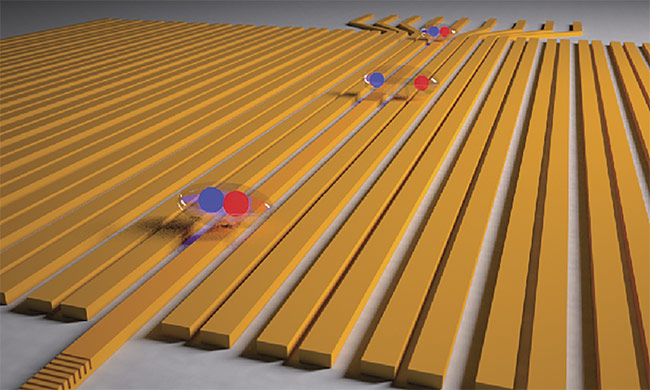
Figure 3. An artistic impression of the bipartite lattice of silicon nanowires with the nonlinearly generated correlated photon pairs represented by red and blue spheres. Adapted from References 5 and 6. Courtesy of Andrea Blanco-Redondo.
Topologically protected states
A foundational experiment demonstrates the protection of biphoton states coupled to a single topological mode. The signatures of topological protection in the nanophotonics lattices discussed above manifest very clearly in the spatial correlation maps. To measure these, a few waveguides that surround the topological defects fan out at the output of the lattice (Figure 3). Each of these waveguides is connected to a series of spectral filters — to suppress the pump and separate signal and idler photons — and polarization controllers, before reaching a series of superconducting nanowire single-photon detectors. The output of these detectors is, in turn, connected to a time-correlation circuit that allows the detection of correlations between signal and idler photons in the same and in different waveguides, yielding the spatial correlation maps (Figure 4).
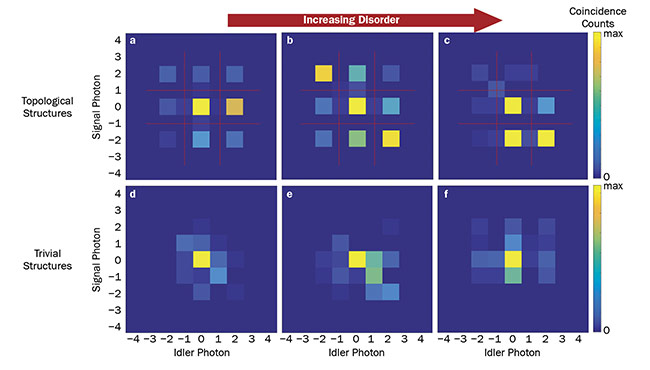
Figure 4. Experimental measurements of the biphoton correlation maps at the output of three topological lattices (a-c) and three trivial lattices (d-f) with increasing levels of disorder. Adapted from References 5 and 6. Courtesy of Andrea Blanco-Redondo.
The correlation maps (Figure 4a-c) show the spatial correlations between signal and idler at the output of three alike topological lattices akin to that represented in Figure 3. The numbers represent the waveguide within the lattice, with zero being the center waveguide in the long-long topological defect and negative (or positive) values representing the adjacent waveguides to its left (or right). The difference between these three lattices is the level of fabrication disorder, with Figure 4a containing no intentionally introduced disorder and Figure 4b and c containing increasing levels of disorder in the position of the silicon nanowires. The key here is to notice that even for increased disorder the amplitude of the odd elements of the map remains zero, save for a few exceptions
within the experimental margin of error. This is a strong signature of topological behavior, as the amplitude of the topological mode in the SSH lattice has zero amplitude in every other site, and this feature is protected against disorder5,7.
For comparison, the measured correlation maps at the output of three analogous lattices with no topological properties is shown (Figure 4d-f). The lattices are engineered to support a localized mode by including a wider waveguide in the center of an otherwise perfect equidistant array of identical nanowires, but this mode is of trivial nature. As a result, the correlation maps do not show any preserved feature in the presence of disorder5.
Protected entangled states
The system described above can be used as a building block to construct topological qubits and thus it provides an excellent platform to investigate the potential of topology to protect quantum information. Two of these building blocks were combined to build spatial entanglement between two topological modes and test the robustness of the resulting quantum state6. Each of these topological defects supports a topologically localized mode, labeled A and B (Figure 5a). A common pump in a weak regime — meaning the probability of generating a photon pair per pulse in each mode is negligible compared to the probability of generating a photon pair in either of the two modes — gives rise to a NOON state. A NOON state is understood to be a path-entangled state in which N particles (here N = 2) are in a superposition of both being in one of the two possible modes, A and B.
This two-photon spatially entangled state was measured at the output of several lattices with various levels of disorder in the position of the waveguides, yielding the biphoton correlation maps (Figure 5b, c). These maps show two clear peaks corresponding to a large number of correlated photon pairs detected in modes A and B, with the signal and idler photons of a pair always detected in the same mode as expected in a NOON state. Furthermore, the zero amplitude in every other element — highlighted by dashed red lines (Figure 5b, c) — and the fact that this zero amplitude is preserved even in the presence of very strong disorder, confirms the topological nature of the two entangle modes. Future experiments will likely include quantum interference measurements at the output of the lattice.
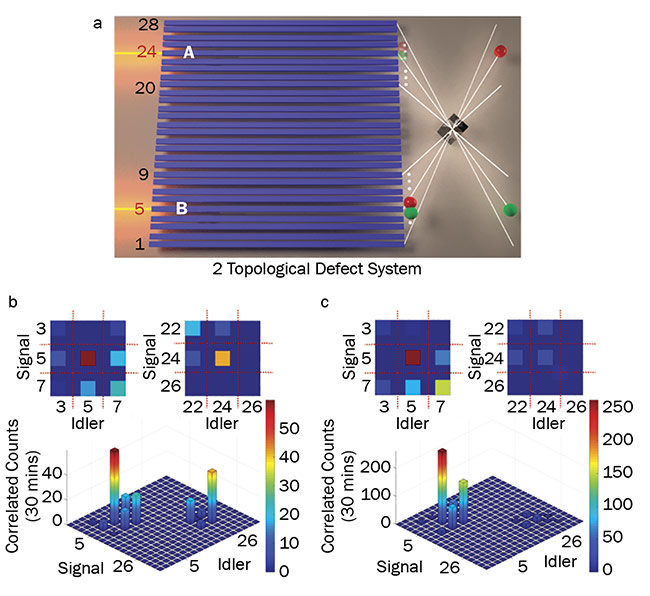
Figure 5. Topological protection of entangled states. An artistic impression of the generation of biphoton entanglement between two topological modes (a) (adapted from Reference 5). Measurements of the correlation map at the output of the lattice represented in (a), which contains a deliberately introduced
disorder in the position of the waveguides (b) (adapted from Reference 6). Similar to (b), with a higher level
of disorder in the position of the waveguides (c) (adapted from Reference 6). Courtesy of Andrea Blanco-Redondo.
Topological quantum photonics is at a very early stage. In the short term, the field is expected to yield new fundamental results based on the use of topology as a new degree of freedom to engineer quantum states of light. In the medium term, the field
could contribute to solving some of the
current challenges of quantum information and quantum computing by making quantum states more robust to fabrication imperfections and environmental changes.
Meet the author
Andrea Blanco-Redondo leads research on topological quantum nanophotonics and nonlinear silicon photonics at Nokia Bell Labs. Formerly, she held positions with Tecnalia and the University of Sydney. Blanco-Redondo has a doctorate from the University of the Basque Country; email: [email protected].
References
1. A. Blanco-Redondo. Topological nano-photonics: towards robust quantum circuits. Submitted for publication.
2. T. Ozawa et al. (2019). Topological photonics. Rev Mod Phys, Vol. 91, p. 015006.
3. M.C. Rechtsman et al. (2016). Topological protection of photonic path entanglement. Optica, Vol. 3, pp. 925-930.
4. S. Mittal et al. (2016). Topologically robust transport of entangled photons in a 2D photonic system. Opt Exp, Vol. 24, p. 15631.
5. A. Blanco-Redondo et al. (2018). Topological protection of biphoton states. Science, Vol. 372, pp. 568-571.
6. M. Wang et al. (2019). Topologically
protected entangled photonic states. Nanophotonics, www.degruyter.com/view/j/nanoph.ahead-of-print/nanoph-2019-0058/nanoph-2019-0058.xml.
7. W.P. Su et al. (1979). Solitons in polyacetylene. Phys Rev Lett, Vol. 42, Issue 25, pp. 1698-1701.